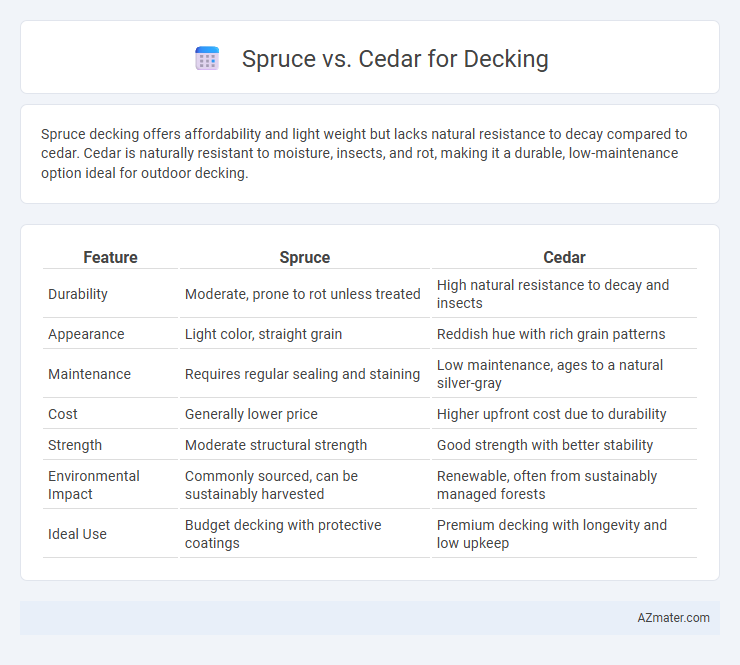Spruce decking offers affordability and light weight but lacks natural resistance to decay compared to cedar. Cedar is naturally resistant to moisture, insects, and rot, making it a durable, low-maintenance option ideal for outdoor decking.
Table of Comparison
| Feature | Spruce | Cedar |
|---|---|---|
| Durability | Moderate, prone to rot unless treated | High natural resistance to decay and insects |
| Appearance | Light color, straight grain | Reddish hue with rich grain patterns |
| Maintenance | Requires regular sealing and staining | Low maintenance, ages to a natural silver-gray |
| Cost | Generally lower price | Higher upfront cost due to durability |
| Strength | Moderate structural strength | Good strength with better stability |
| Environmental Impact | Commonly sourced, can be sustainably harvested | Renewable, often from sustainably managed forests |
| Ideal Use | Budget decking with protective coatings | Premium decking with longevity and low upkeep |
Introduction to Spruce and Cedar Decking
Spruce decking offers a lightweight, cost-effective option with good strength and a pale, uniform color ideal for painting or staining. Cedar decking is prized for its natural resistance to decay and insect damage, featuring a rich reddish hue and fine grain that enhance outdoor aesthetics. Both woods provide unique advantages for decking projects, with spruce favored for affordability and cedar for durability and visual appeal.
Wood Characteristics: Spruce vs Cedar
Spruce decking offers a light color with a fine, consistent grain and is known for its strength and affordability but requires regular maintenance to resist moisture and insect damage. Cedar features natural oils that provide excellent resistance to rot, decay, and insect infestation, with a warm reddish hue and smooth texture that ages gracefully. Both woods are lightweight and easy to work with, yet cedar's durability and weather resistance make it a preferred choice for long-lasting decking.
Durability and Lifespan Comparison
Spruce decking offers moderate durability with a typical lifespan of 10 to 15 years when properly maintained, making it suitable for budget-conscious projects. Cedar boasts natural resistance to rot and insect damage, extending its lifespan to 20 years or more with minimal treatment. The superior durability of cedar results from its dense grain structure and natural oils, which protect against moisture and weathering better than spruce.
Resistance to Weather and Insects
Spruce decking offers moderate resistance to weather but requires regular sealing to prevent moisture damage and decay. Cedar naturally contains oils that make it highly resistant to insects and weathering, reducing the need for chemical treatments. Cedar's superior durability against rot and insect infestation makes it a preferred choice for outdoor decking in harsh climates.
Appearance and Aesthetic Differences
Spruce decking offers a pale, uniform color with a fine, straight grain that ages to a soft silver-gray, creating a clean, minimalist look. Cedar features rich reddish-brown hues and a pronounced, varied grain pattern that imparts warmth and rustic charm to outdoor spaces. Both woods provide distinctive aesthetic qualities, with spruce appealing to modern designs and cedar complementing traditional or natural styles.
Maintenance Requirements for Each Wood
Spruce decking requires regular sealing and staining to protect against moisture and prevent warping, as its softer grain is more prone to damage and rot. Cedar offers naturally higher resistance to decay and insect infestation, significantly reducing maintenance frequency, though it still benefits from periodic sealing to maintain color and durability. Both woods need routine cleaning, but cedar's inherent oils provide better long-term protection with less intensive upkeep compared to spruce.
Cost Comparison: Spruce vs Cedar
Spruce decking typically costs less per board foot compared to cedar, making it a budget-friendly option for large projects. Cedar offers natural resistance to rot and insects, which may reduce long-term maintenance expenses despite its higher upfront price. Choosing spruce requires applying sealants and preservatives to match cedar's durability, impacting overall cost-effectiveness over time.
Environmental and Sustainability Factors
Spruce decking offers a fast-growing, renewable resource with a lower environmental footprint due to its abundant availability in northern forests. Cedar is naturally resistant to decay and insects, reducing the need for chemical treatments that can impact ecosystems and human health. Both woods are biodegradable and can be sustainably sourced through responsible forest management practices certified by organizations like FSC, supporting long-term ecological balance.
Installation Considerations
Spruce decking offers ease of installation due to its lightweight nature and straight grain, reducing labor time and effort compared to cedar, which can be denser and harder to work with. Cedar requires pre-drilling to prevent splitting and may need specialized fasteners to resist corrosion caused by its natural oils, while spruce is compatible with standard decking hardware. Proper installation techniques for both woods ensure durability and stability, but spruce's uniform texture makes it more forgiving during cutting and fastening processes.
Choosing the Right Wood for Your Deck
Spruce offers affordability and light color but lacks the natural rot resistance and durability of cedar, which is prized for its rich color, aromatic properties, and resistance to decay and insects. Cedar contains natural oils that protect the wood from moisture and pests, making it a superior choice for outdoor decking that requires longevity and minimal maintenance. When selecting wood for decking, prioritizing factors such as weather resistance, durability, and aesthetic appeal ensures the deck will perform well in various climates and maintain its beauty over time.

Infographic: Spruce vs Cedar for Decking
 azmater.com
azmater.com